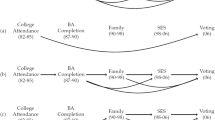Abstract
Conventional wisdom suggests that union members and their families are more politically active, and more likely to vote, than nonmembers. This study presents, to our knowledge, the first systematic empirical examination of that conventional wisdom. Results suggest that union members are more likely than nonmembers to vote in a general election, and that union campaign efforts increase voter turnout generally. There is no evidence, however, that union family members are more likely to vote than nonmembers, or that union status affects an individual’s likelihood of voting in a primary election.
Similar content being viewed by others
References
Aaron, Benjamin. “Future Trends in Industrial Relations Law.”Industrial Relations 23 (Winter 1984): 52–57.
Abramowitz, Alan I. “Economic Conditions, Presidential Popularity, and Voting Behavior in Midterm Congressional Elections.”Journal of Politics 47 (February 1985): 31–43.
Abramson, Paul R. and William Claggett. “Race-Related Differences in Self-Reported and Validated Turnout.”Journal of Politics 46 (August 1984): 719–38.
AFL-CIO. “Poll Taps Views of Teleconference Participants.”AFL-CIO News 31 (June 21, 1986): 5.
_____. “Register.”AFL-CIO News 21 (September 4, 1976): 8.
Bok, Derek C. and John T. Dunlop.Labor and the American Community. New York: Simon and Schuster, 1970.
Bureau of National Affairs. “Importance of Politics to Labor Emphasized at RWDSU Convention.”Employee Relations Weekly (June 23, 1986a): 781–82.
_____. “OPEIU Convention Stresses Stepped-Up Political Action.”Employee Relations Weekly (June 30, 1986b): 813–14.
Caldeira, Gregory A., Samuel C. Patterson, and Gregory A. Markko. “The Mobilization of Voters in Congressional Elections.”Journal of Politics 47 (May 1985): 490–509.
Campbell, Angus, Philip E. Converse, Warren E. Miller, and Donald E. Stokes.The American Voter. New York: Wiley, 1960. University of Chicago Press Edition, 1980.
Cassel, Carol A. and David B. Hill. “Explanations of Turnout Decline: A Multivariate Test.”American Political Quarterly 9 (April 1981): 181–96.
Crain, W. Mark, Donald R. Leavens, and Lynn Abbot. “Voting and Not Voting at the Same Time.”Public Choice 53 (1987): 221–29.
Downs, Anthony.An Economic Theory of Democracy. New York: Harper and Row, 1957.
Durden, Garey C. and Patricia Gaynor. “The Rational Behavior Theory of Voting Participation: Evidence from the 1970 and 1982 Elections.”Public Choice 53 (1987): 231–42.
Enelow, James M. and Melvin J. Hinich.The Spatial Theory of Voting. Cambridge: Cambridge University Press, 1984.
Fishbein, Martin and Icek Ajzen.Belief, Attitude, Intention and Behavior: An Introduction to Theory and Research. Reading, MA: Addison-Wesley, 1975.
Form, William. “Self-Employed Manual Workers: Petty Bourgeois or Working Class?”Social Forces 60 (June 1982): 1050–70.
Foster, Carroll B. “The Performance of Rational Voter Models in Recent Presidential Elections.”American Political Science Review 78 (September 1984): 678–90.
Freeman, Richard B. and James L. Medoff.What Do Unions Do? New York: Basic Books, 1984.
Geer, John G. “Voting and the Social Environment.”American Political Quarterly 13 (January 1985): 3–27.
Hamilton, Richard F.Class and Politics in the United States. New York: John Wiley and Sons, 1972.
Hansen, Stephen, Thomas R. Palfrey, and Howard Rosenthal. “The Downsian Model of Electoral Participation: Formal Theory and Empirical Analysis of the Constituency Size Effect.”Public Choice 52 (1987): 15–33.
Kirkland, Lane. “Labor and Politics After 1980.”American Federationist 88 (January 1981): 18–20.
Kloska, George. “Rebellious Collective Action Revisited.”American Political Science Review 81 (June 1987): 557–61.
Muller, Edward N. and Karl-Dieter Opp. “Rational Choice and Rebellious Collective Action.”American Political Science Review 80 (June 1986): 471–87.
_____. “Rebellious Collective Action Revisited.”American Political Science Review 81 (June 1987): 561–64.
Palfrey, Thomas R. and Howard Rosenthal. “Voter Participation and Strategic Uncertainty.”American Political Science Review 79 (March 1985): 62–78.
Powell, G. Bingham, Jr. “American Voter Turnout in Comparative Perspective.”American Political Science Review 80 (March 1986): 17–43.
Ra, Jong Oh.Labor at the Polls: Union Voting in Presidential Elections. Amherst: University of Massachusetts Press, 1978.
Sigelman, Lee, Philip W. Roeder, Malcolm E. Jewell, and Michael A. Baer. “Voting and Nonvoting: A Multi-Election Perspective.”American Journal of Political Science 21 (November 1985): 749–65.
Southwell, Priscilla L. “Alienation and Nonvoting in the United States: A Refined Operationalization.”Western Political Quarterly 38 (December 1985): 663–74.
Tucker, Harvey J. “Contextual Models of Participation in U.S. State Legislative Elections.”Western Political Quarterly 39 (March 1986): 67–78.
Tullock, Gordon.Toward a Mathematics of Politics. Ann Arbor: University of Michigan Press, 1967.
Wilson, Graham K.Unions in American National Politics. New York: St. Martin’s Press, 1979.
Wolfe, Arthur. “Trends in Labor Union Voting Behavior, 1948–1968.”Industrial Relations 9 (October 1969): 1–10.
Wolfinger, Raymond E. and Steven J. Rosenstone.Who Votes? New Haven: Yale University Press, 1980.
Author information
Authors and Affiliations
Additional information
The authors wish to thank Robert Perloff, Donna Sockell, and an anonymous referee for helpful comments on an earlier draft of this paper. This study was partially supported by a Columbia University Graduate School of Business Faculty Research Fellowship and a Faculty Research Grant from the University of Pittsburgh Graduate School of Business.
Rights and permissions
About this article
Cite this article
Delaney, J.T., Masters, M.F. & Schwochau, S. Unionism and voter turnout. Journal of Labor Research 9, 221–236 (1988). https://doi.org/10.1007/BF02685314
Issue Date:
DOI: https://doi.org/10.1007/BF02685314




